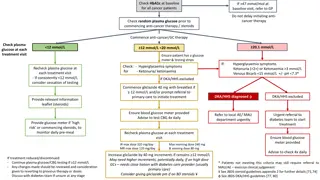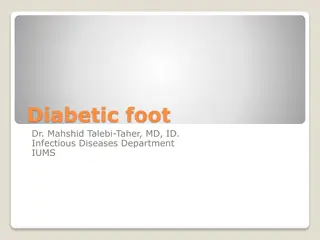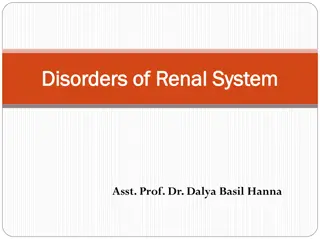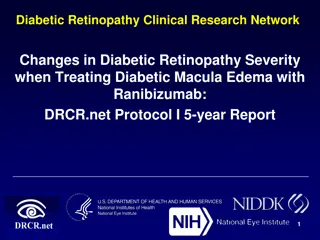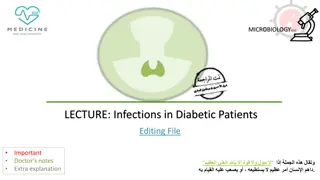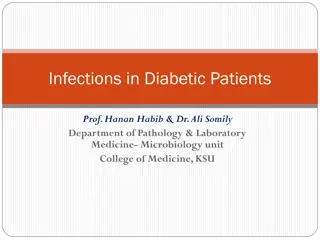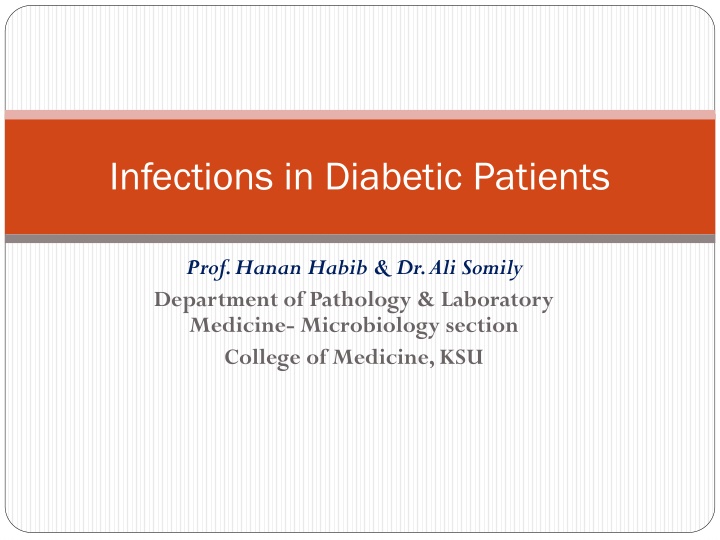
Infections in Diabetic Patients: Risk Factors and Management
Discover the risk factors and management of infections in diabetic patients, focusing on diabetic foot infections and common complications of diabetes mellitus. Learn about host-related factors and how hyperglycemia can facilitate infection, along with clinical presentations and antimicrobial therapy options. Stay informed about the pathogenesis of common infections and laboratory tests involved.
Download Presentation

Please find below an Image/Link to download the presentation.
The content on the website is provided AS IS for your information and personal use only. It may not be sold, licensed, or shared on other websites without obtaining consent from the author. If you encounter any issues during the download, it is possible that the publisher has removed the file from their server.
You are allowed to download the files provided on this website for personal or commercial use, subject to the condition that they are used lawfully. All files are the property of their respective owners.
The content on the website is provided AS IS for your information and personal use only. It may not be sold, licensed, or shared on other websites without obtaining consent from the author.
E N D
Presentation Transcript
Infections in Diabetic Patients Prof. Hanan Habib & Dr. Ali Somily Department of Pathology & Laboratory Medicine- Microbiology section College of Medicine, KSU
OBJECTIVES OBJECTIVES To identify the risk factors to develop infection in diabetic patients. To recognize common infections in diabetic patients ( with emphasis on diabetic foot infection). To be familiar with the causative organisms and pathogenesis of common infections . To know the clinical presentations of common infections. To specify the laboratory and radiological tests of common infections To recognize the common complications of diabetes mellitus ( diabetic foot ). To be aware about the management and antimicrobial therapy of common infections in diabetic patients.
Introduction Introduction Diabetic patients are predisposed to infections Nearly half of all diabetic patients had at least one hospitalization or outpatient visit for infections compared to non-diabetic patients. Infections may increase the morbidity and mortality in diabetic patients. Why diabetic patients are at increased risk to have infections? Because of Host related factors & Organisms related factors:
Host Related Factors Host Related Factors Vascular insufficiency result in local tissue ischemia that enhances the growth of microarophilic and anaerobic organisms while depressing the O2 dependent bactericidal functions of leukocytes. There may be also impairment of the local inflammatory response and absorption of antibiotics. Sensory peripheral neuropathy. Minor local trauma may result in skin ulcers, which leads to diabetic foot infections. Autonomic neuropathy: Diabetic patients may develop urinary retention and stasis that ,in turn, predisposes to develop UTIs.
Host Related Factors Hyperglycemia and metabolic derangements in diabetes may facilitate infection. Immune defects in diabetes such as: - Depressed Neutrophil function - Affected adherence to the endothelium. - Affected chemotaxis and phagocytosis - Compromised bactericidal activity. - Depressed cell mediated immunity
Host Related Factors Increased skin and mucosal colonization Diabetics on insulin have asymptomatic nasal and skin colonization with S.aureus ,particularly MRSA. Colonization predisposes to skin infection and transient bacteraemia which may result in distal sites infection such as damaged muscle. In type- 2 diabetes ;mucosal colonization with C.albiacns is common. Vulvovaginitis caused by non-albicans Candida spp. is common in patients with poor glycemic control.
Host Related Factors Surgical site infections associated with postoperative hyperglycemia which is related to deleterious effect on chemotaxis, phagocytosis and adherence of granulocytes
Organism Specific Factors Organism Specific Factors Candida albicans glucose inducible proteins promote adhesion of C.albicans to buccal or vaginal epithelium which in turn, impairs phagocytosis, giving the organism advantage over the host. Rhizopus spp.-ketoacidosis allow Rhizopus spp. which cause Mucormycosis (Zygomycosis) to thrive in high glucose acidic conditions . http://t2.gstatic.com/images?q=tbn:ANd9GcRt9LyzSpL5B81CJVBXdvlZXLLbkiqGyAnNOQqPKAwN0iWT-MJeS2o3Ug http://t1.gstatic.com/images?q=tbn:ANd9GcQwXXKjyi_afisNAKiHnRU2U608NKgxItXAQ4gHrmLNfKs5XHt6FgBjnWA
Common infections in diabetic patients Common infections in diabetic patients Upper & lower respiratory tract infections Periodontal infections Genitourinary infections Abdominal infections Skin and soft tissue infections & diabetic foot
Upper Respiratory Tract Infections Upper Respiratory Tract Infections Invasive ( malignant) ottitis media, uncommon but potentially life threatening. Rhinocerebral mucormycosis Invasive ottitis Externa Cause:P.aeruginosa. Slowly invades from the external canal into adjacent soft tissues, mastoid and temporal bone and eventually spreads across the base of the skull. s/s :Patient present with severe pain, otorrhea, and hearing loss. Intense cellulitis and oedema of the ear canal. Diagnosis: CT and MRI studies to define the extent of bone destruction. Treatment: surgical debridement & IV anti-pseudomonas antibiotics.
Rhinocerebral Rhinocerebral Mucormycosis Mucormycosis A life threatening fungal infection Cause: (Mucormycosis )Rhizopus, Absidia and Mucor species. Clinically: facial or ocular pain and nasal stuffiness, generalized malaise and fever. May be intranasal black eschars or necrotic turbinates. Diagnosis: biopsy of necrotic tissue Treatment: surgical debridement and prolonged IV therapy with Amphotericin B .
Lower respiratory tract infections Lower respiratory tract infections pneumonia and influenza pneumonia and influenza Diabetic patients are 4 times more likely to die from pneumonia or influenza than non-diabetic patients. Common organisms: Gram positive bacteria :S.aureus , S.pneumoniae. Gram negative bacteria: Enterobacteria and Legionella. Other organisms: Influenza virus & Mycobacterium tuberculosis . Routine pneumococcal vaccination and influenza recommended.
http://t2.gstatic.com/images?q=tbn:ANd9GcTqf8ek3jzFpmw5uU91RdpI1yI5ZQ0x43PO3uT1GQLhqR3cITe57lUqqAhttp://t2.gstatic.com/images?q=tbn:ANd9GcTqf8ek3jzFpmw5uU91RdpI1yI5ZQ0x43PO3uT1GQLhqR3cITe57lUqqA http://t1.gstatic.com/images?q=tbn:ANd9GcTt28VVfWkq_mEC6ecGOTGYTmXOf_U3LFB4o4LZPyPAulxsWqZlKVNnXg http://t3.gstatic.com/images?q=tbn:ANd9GcTDbAN0n_7J8Oe1gCzguh3c90OU7J1I4aD7eFXMJYdkNEvscGT9wb7VQo6Q http://t0.gstatic.com/images?q=tbn:ANd9GcRvYUiPGww_IXTztr2FKN8QvIkVqW2Xlpx2XmTGV-Xl4LQHXc7U9GH51vZJ http://t2.gstatic.com/images?q=tbn:ANd9GcQiqcLDTPKYGcKABXcSI3UEFVCWqseYK2ZlgBwGsVFLP-l0nFY0dVkSN2I
Genitourinary infections Genitourinary infections Asymptomatic bacteriuria ( > 100,000 /ml urine) is common. Symptoms/ Signs and time of onset similar to non-diabetics. Diabetes is an indication for screening for treating asymptomatic bacteriuria. Cystitis: same as non-diabetics, incomplete bladder emptying and high incidence of unsuspected upper UTI. Bacteria ( Gram negative rods or group B streptococci) or fungi (Candida albicans ) may be involved.
Bilateral Pyelonephritis: diabetes predisposes to a more severe infection of the upper urinary tract. Emphysematous Pyelonephritis exclusively an infection of diabetics ( 60%) and carries grave prognosis ( 30% fatal). Diagnosis: flank mass & crepitus . CT show gas in the renal tissues. Management:supportive & IV antibiotics , nephrectomy may be needed. Vulvovaginitis : as mentioned earlier.
Abdominal infections Abdominal infections Severe fulminating Cholecystitis Common causes: enteric Gram negative bacteria and anaerobes. Gall stone or peritonitis may be present. Gas gangrene and perforation may occur. Management: Cholecystectomy and broad spectrum antibiotics
Skin and soft tissue infections Skin and soft tissue infections Risk factors in diabetic patients : - Sensory neuropathy: no pain perception. - Atherosclerotic vascular disease - Hyperglycemia : >250 mg/ dl increased risk - H/O of cellulitis, peripheral vascular diseases, Tinea, and dry skin. Organisms: Streptococcus pyogenes ( GroupA Streptococcus (GAS) ) and S.aureus CA-MRSA ( community acquired -MRSA) is of concern causes (77%) of skin and soft tissue infections .
http://t1.gstatic.com/images?q=tbn:ANd9GcSN8Aa3RjFyiwp3AIlkBXXcUTSQRjRLThOn_AtnOah5gsl8SkeV9jCtReEhttp://t1.gstatic.com/images?q=tbn:ANd9GcSN8Aa3RjFyiwp3AIlkBXXcUTSQRjRLThOn_AtnOah5gsl8SkeV9jCtReE Necrotizing fasciitis :a deep seated ,life threatening infection of subcutaneous tissue with progressive destruction of fascia, fat and muscle. Causes :10% associated with GAS ,with or without S.aureus, anaerobes may be involved. Clinically: pain of proportion of skin, anaesthesia of overlying skin. Violaceous discoloration of skin that evolves into vesicles and bullae, crepitus ,soft tissue gas seen in radiograph or CT scan. Management :aggressive surgical debridement & IV antibiotics.
Diabetic foot infection Diabetic foot infection the most common and most important soft tissue infection in diabetic patients, why ? because it is related to peripheral neuropathy and compromised microvascular circulation which limits the access of phagocytic cells to the infected area and poor concentration of antibiotics in the affected area. Complicated by chronic Osteomyelitis, gas gangrene, amputation and death.
The spectrum of foot infection ranges from superficial cellulitis to chronic Osteomyelitis. Combined infection involving bone and soft tissue may occur . Pathophysiology: microvascualr disease limits blood supply to the superficial and deep structures. Pressure from ill fitting shoes ,trauma compromises local blood supply predisposing foot to infection.
Infection may involve the skin, soft tissues, bone ,or all. Diabetic neuropathy may lead to incidental trauma that goes unrecognized. Sinus tract may be present
Organisms involved in diabetic foot Organisms involved in diabetic foot infections infections Cellulitis: : beta-hemolytic streotococci ( group A,B streptococi ), S.aureus, Entertobacteriacae ( E.coli, Klebsiella, Proteus spp.) in chronic ulcers. Macerated ulcer or nail injury ( sinus) : P.aeruginosa . Deep soft tissue infections (necrotizing fasciitis, or myositis).GAS & gas producing gram positive bacilli (Clostridium ). Chronic Osteomyelitis: GAS and Group B Sterptococcus, S.aureus, Enterobacteriacae (E.coli ,Proteus mirabilis , K.pneumoniae.) & Bacteroides fragilis
Factors that increases the development of Osteomyelitis: grossly visible bone or ability to probe to bone, ulcer size >2x2 cm, ulcer depth > 3mm, ulcer duration longer than 1- 2 wks, ESR >70 mm/hr http://t0.gstatic.com/images?q=tbn:ANd9GcQGNHgQTPOdan3Lao9pQStQL45Qq7F4OyhWO1XskJIkYO6efit7R4znsA http://t2.gstatic.com/images?q=tbn:ANd9GcS6kNR52eEp1WLLOzrb1V4fxc2FR6cnn9LBgxVrKqjMrpGpu_bWoV7DyQ http://t0.gstatic.com/images?q=tbn:ANd9GcSjt4sfGZXjYUb3YNyHmWmjV4KA9fHi-2GTr9uj3h38SCk__Aa0gPJy5c0 http://t3.gstatic.com/images?q=tbn:ANd9GcRJbp0T1NJLIRKMb2e1ZPyLI7jGgWDDcPDUI9DefgoS8cf4TUBphGYqlrg
Clinical presentations of diabetic foot Clinical presentations of diabetic foot infections infections Cellulitis: tender, erythematous non-raised skin lesion on the lower limb ,may be accompanied with lymphangitis which suggests GAS. Bullae suggests S.aureus ,occasionally GAS. Deep skin and soft tissue infections: patient acutely ill, with painful induration of the limb especially the thigh . Foot may be involved. Wound discharge suggest anaerobes http://t0.gstatic.com/images?q=tbn:ANd9GcToDuUbGRUnGOr2t61ejmtCYgiuPOkUVKQBjw8ujTtXeDZQD47Z8j8nsCM
Acute Osteomyelitis: pain at the involved bone, fever, adenopathy. Chronic Osteomyelitis: fever ,foul discharge , may be pain, no lymphangitis, deep penetrating ulcer ,and sinuses on the planter surface of the foot
Diagnosis of foot infections Diagnosis of foot infections Thorough examination to evaluate the patient s vascular and neurological status. Radiological examination including doppler ultrasonography ,transcutaneous oxymetery, MR angiography. CT scan ,MRI and gallium -67 scan for soft tissue and bone evaluation. Exploration of ulcer to determine its depth and presence of sinus tract. Deep specimens (tissues) for culture and susceptibility testing .
Management & Treatment Management & Treatment Control blood sugar and hydration Evaluation of neuropathy and vasculopathy Mild cases: debridement of necrotic tissues and use of antibiotics according to the causative bacteria eg. Cloxacillin, Cephradine, Clindamycin , TMP-SMX (for CA-MRSA), Aminoglycosides, Quinolones. Moderate to severe cases : places the foot at risk of amputation. Needs hospitalization ,IV antibiotics and surgical intervention if needed.
Prevention Prevention is the cornerstone of diabetic foot care. It is multidisciplinary including family physician, social worker, home care nurse and specialist. Patient education about the control and complication of diabetes. Blood sugar should be controlled promptly ( shift to insulin if oral hypoglycemic agents were not effective),weight reduction, a diet low in fat and cholesterol. Proper foot care, using protective footwear and pressure reduction. Self and family member examination of foot.




